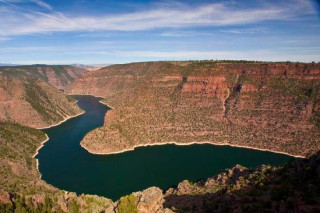Explorer Corps Marker: Daggett County
Find the Marker
The Daggett County marker is at the Red Canyon Visitor Center in Dutch John, and offers a wonderful view of the Canyon. The Visitor Center is located about 40 miles north of Vernal.
GPS 40°53’30.84”N 109°33’40.68”W
Dig Deeper
Utah is a state full of geologic wonders, from the fins and arches around Moab to the slot canyons of Grand Staircase-Escalante National Monument. The story of Deep Time seems to be on display all over the state. But among all the places to get in touch with prehistory, there are few where you can really get a feel for the vast sweep of the ages. Red Canyon Overlook in Daggett County is one such vantage point, a view of more than 600 million years of Earth’s history.
Even though many of the rock layers visible from Red Canyon Overlook can be seen elsewhere in Utah, the elevated Overlook is one of the few places where you can see rocks that span most of the Age of Dinosaurs atop ancient rocks more than 750 million years old – tens of millions of years before the first animals evolved. And each layer tells a story.
The story told by Red Canyon Overlook isn’t continuous, like a great geologic book, but is instead more like an anthology of different times. The oldest rocks in the stack were formed more than 750 million years ago when ancient rivers and deltas flowed into an ocean that rested just to the west of Utah’s prehistoric location, carrying a great deal of mud, silt, and sand with them. All that deposition created those incredibly old layers.

Over time, these layers subsided and sunk lower compared to the rest of the landscape to provide the foundation for newer environments. Between 250 and 205 million years ago, rivers and streams started to wander and weave over the landscape, the very beginning of a succession of environments that would again add layer after layer on top of each other.
From 205 and 180 million years ago, the area was a vast desert. Then a shallow sea covered the area until 170 million years ago, followed by more sand dunes for another five million years, another five-million-year inundation by the ocean, five million years of rivers and streams, and finally another five million years of shallow seas, the nature of this particular spot on the planet shifting back and forth as the continents moved and the climate changed. Given that the first dinosaurs evolved about 235 million years ago and most – except birds – died out 66 million years ago, the stacks of Red Canyon Overlook rocks record almost the entirety of the Mesozoic, or what paleontologists sometimes call the Age of Dinosaurs.
All of these rocks didn’t lay exposed through the entire span. Each environment laid down its distinctive sediments, creating layers in the Earth’s crust, until later geologic events, like rising mountains and streams capable of eroding stone, brought them to the surface and carved the outcrops into their modern shape. And if you know what to look for, you can read the comings and goings of lost worlds through each section of prehistoric stone.
Want to Go Farther?
Go inside the Red Canyon Visitor Center to learn about local geology and activities in the area.